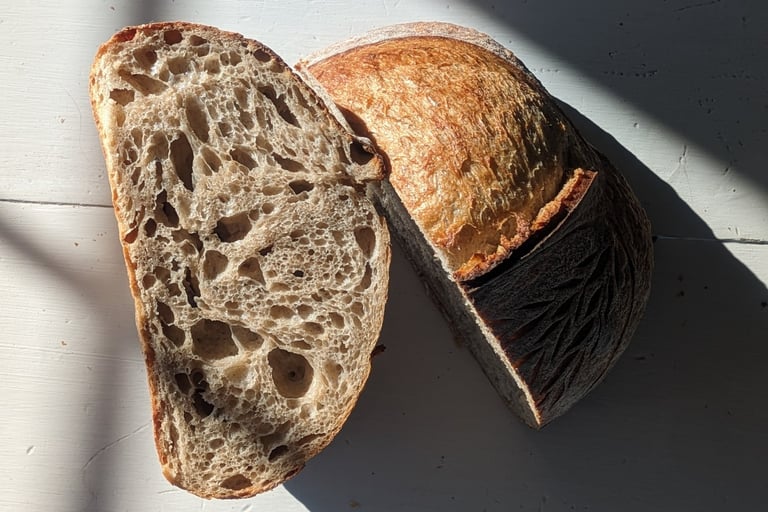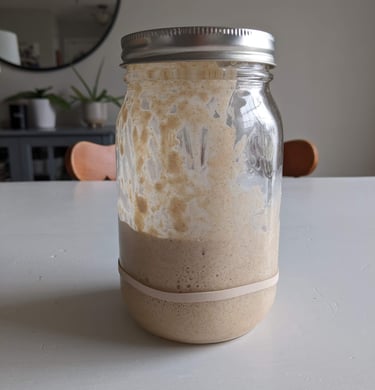Feeding Your Sourdough Starter 101
Sourdough starter is the life of your bread! A strong starter will yield a beautiful loaf of sourdough. Here I go over how to maintain and feed your starter.


What is Starter? Sourdough starter is a mixture of flour and water that captures wild yeast and beneficial bacteria from the environment. Over time, this concoction ferments, developing a colony of microorganisms that help to leaven bread.
When you incorporate starter into your bread dough, the wild yeast feeds on the sugars in the flour, producing carbon dioxide gas and alcohol as byproducts. The carbon dioxide gets trapped in the dough’s protein structure, causing it to rise and creating a light, airy texture. In addition to helping bread rise, the bacteria in the starter contribute to the unique tangy flavor characteristic of sourdough. This natural fermentation process not only enhances the bread's taste but also improves its shelf life and nutritional value!
How to Care for Your Sourdough Starter


How to feed your starter!
To successfully feed and take care of a sourdough starter, begin by ensuring it is kept in a clean, breathable container. Your starter needs room to breath and will release gasses while it ferments, so it's important that you make sure to leave it room to breath. My favorite way to store my starter is in a glass jar with the lid gently set on top. Another option is to cover the jar with a coffee filter and secure it with a rubber band. You'll just want to avoid tightly securely any type of lid atop your starter.
What you'll need:
- A glass jar and lid
- a food scale
- a small bowl
- a spoon
- water
- unbleached flour
Your starter's food consists of flour and water. A general rule to follow is to feed your starter equal parts starter, flour, and water. If you don't have a food scale you can use measuring cups, however a food scale is just more accurate at measuring.
Feeding instructions for Making Bread:
1.) Place your bowl on a food scale and measure out 25g (approx. 1 heaping TBLS) of starter. (You may have leftover starter. This is called "discard". Place it in a separate jar and kept in your fridge to use for sourdough discard recipes like cookies or banana bread.)
2.) Add 50g (1/4 cup) of room temperature or slightly warm to touch water. Mix well.
3.) Add 50g (1/2 cup) of unbleached flour. (I prefer King Arthur bread flour.) Mix well until no dry bits of flour remain.
4.) Put your now "fed" starter into your glass jar and place a lid or coffee filter on top. Your starter should be the consistency of a thick pancake batter.
5.) Place your jar of starter in a warm spot on your counter. 68F-75F is ideal.
6.) Wait 8-12 hours. You’ll notice bubbles forming and the starter will at least double in size, indicating that it’s healthy and ready for baking!


Daily Feeding Schedule:
1.) Mix 15g starter, 15g of water and 15g of flour together.
2.) Loosely cover the jar and let it rise at room temperature.
After feeding you will have about 30g of unused starter left. This is “discard” and can be thrown away or placed in the fridge as a backup starter or to be used for recipes.
To maintain a strong starter you will want to feed it approximately every 24 hours, but can be fed as soon as 12 hours (unless you keep it in the fridge - see below). Finding a good feeding rhythm that works for your schedule is very helpful. Many bakers prefer a night time feed, so that their starter is doubled in size and ready to mix dough when they wake in the morning. Maybe feeding in the morning works best for you. Either way find a time that's just a part of your daily routine!
There are two primary ways to store your sourdough starter. Your starter can be kept at room temperature/on the counter, or in the refrigerator.
If you are planning to make bread, you'll want to feed and store your starter at room temperature. If you're not wanting to make bread, are going on vacation, or just not wanting to feed your starter so frequently, it's best to keep your sourdough starter in the refrigerator, as the cold temperature slows down the fermentation process allowing your starter to go unfed several weeks, or even a month without being fed. It’s important to note that the longer you leave a starter unfed in the refrigerator, the more it may become sluggish. Before using a refrigerated starter, it's a good idea to feed it a couple of times at room temperature to reactivate it fully.
Can my starter go bad?
The answer is yes, but it is probably harder than you think to "kill" a starter. A sluggish starter, meaning one that doesn't double in size or has minimal bubbles, does not necessarily mean it's gone bad. My rule of thumb, unless you smell or see mold (orange growth on top of your starter), your starter is most likely ok. If your starter smells alcohol like or has a dark liquid "hooch" on top, that just means it's very hungry. Simply pour off the liquid and feed. I have definitely left my starter unfed on the counter for 2 days, and neglected in my fridge for a couple months, and it survived both! A sluggish or hungry starter might take 3-4 feeds to get it's strength back!
With consistent care, your sourdough starter will develop a rich flavor and texture, and I'm confident you will fall in love with the process of bread making!
-Katie
"Bread is art too!"
Check out my list of Sourdough essentials! #affiliate
You can purchase my Beginner Sourdough Recipe at one of my weekly porch pickups here.
Your starter is ready to make bread when it is bubbly and doubled in size. I like to place a rubber band on my jar so that I easily see when it has doubled in size.


